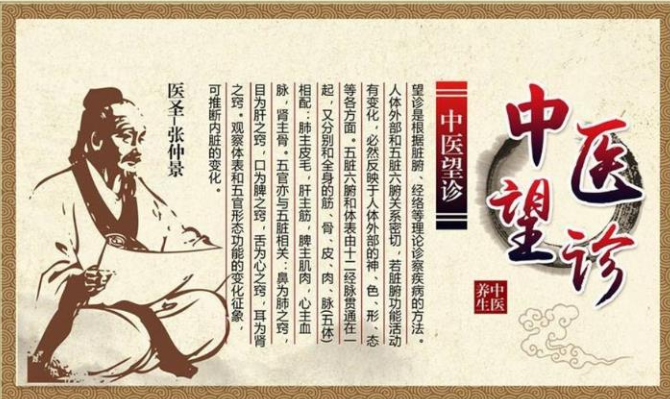
Introduction: Wang Zhen (望诊) refers to the practice of using visual observation by the physician to assess all visible signs of the human body and excretions to understand health or disease status.
The content of Wang Zhen mainly includes observing the spirit, color, shape, posture, tongue appearance, collaterals, skin, and the five sense organs, as well as the shape, color, and quality of excretions and secretions. Wang Zhen is divided into overall observation and partial observation.
Comprehensive Guide to TCM Observation Diagnosis
Kidney deficiency leads to dark circles under the eyes, lung heat results in a red nose, liver excess causes red eyes, cold leads to dark cheeks, wind causes blue eyes,
phlegm-dampness results in yellow eyes, excessive phlegm leads to swollen eyes, cold causes blue lips, kidney failure leads to dark ears, dampness causes yellow skin,
liver heat causes dry skin, spleen heat results in red cheeks, mixed colors lead to dim eyes, foot injuries cause a heavy neck. Blood loss leads to dark complexion,
diarrhea causes a pale face, qi deficiency leads to facial swelling, excessive sweating causes blue lips, pain leads to furrowed brows. Dry heat causes a dark forehead,
the forehead should be replenished with water, pale lips should avoid cold, red cheeks clear liver and lung, excessive fat indicates phlegm needs to be eliminated. Thin people have excess liver fire,
weak qi should be prevented, throat discomfort leads to choking on food, mouth discomfort indicates stomach cold, diarrhea causes a yellow-white face. Abdominal pain leads to pale lips,
dark blue face prevents diarrhea, round protruding eyes prevent mania, resembling a crane indicates tuberculosis, like purple indicates bone steaming. Fear causes a blue-black face,
absolute stomach cold leads to a blue mouth, poisoning leads to a white mouth, red blood indicates disease, a yellow face resembles dyed paper, intestinal wind and blood collapse,
sunken eyes indicate eye disease, ugly nose indicates waist discomfort, strange black areas indicate worry, spots also require evaluation. Suspended needle locks the seal,
the middle burner disease must be established , the nose has three bends, hands and feet should be cautious, excessive phlegm leads to a shiny face. Qi tightness indicates waist pain prevention,
dark ears indicate impending death, all diseases should be checked here, do not rush in clinical symptoms.

Facial Diagnosis Mnemonics
In all medical cases, observation comes first. Vital energy and spirit are the most important. Organ positions must be remembered. Multiple shadows should be distinguished.
Many diseases arise from qi and blood. A blue face indicates cold pain. A lustrous face indicates abundant qi and blood. A red face indicates fire.
Red like makeup indicates false fire. A black face indicates liver and kidney issues. A pale face indicates deficiency and cold. A white face without luster indicates blood deficiency.
A yellow face with luster indicates damp-heat. A dark yellow face indicates liver and kidney disease. A bright forehead indicates good spirit. A dark forehead indicates disaster.
Bright eyes indicate no major illness. Dull eyes indicate qi deficiency. Red eyes indicate internal fire. Yellow whites indicate liver and gallbladder disease.
A missing iris indicates brain disease. A large gastric ring indicates poisoning. Black vertical lines indicate inflammation. Black depressions indicate structural damage.
Itchy dermatitis indicates gray around the iris. Hard blood vessels indicate white rings. Iris diagnosis is a vast knowledge. Concentric circles are key.
Multiple segments arranged in circles. Each circle represents the whole body. Eyes are like fish, valuable and bright. A shiny nose indicates no major illness.
A blue nose indicates cold injury. A white nose indicates blood injury. A red nose indicates absolute stomach qi. An irregular nose indicates serious illness.
A mole on the nose indicates danger. A bright philtrum indicates no major illness. A full tear hall indicates fullness. A dry blue-black indicates kidney deficiency.
Insomnia indicates mental injury. A flat groove indicates lack of strength. A sore philtrum indicates stomach fire. A crooked philtrum indicates short life.
Pale red lips indicate no major illness. White lips indicate blood injury. Blue-purple lips indicate cold pain and stasis. A shiny face indicates water accumulation.
A yellow-black face indicates fatty liver. A burnt ear indicates cancer. A thin face requires caution. If there is no illness, there must be weight gain.
Clear features from ten steps away indicate longevity. Clear positions and five colors indicate clarity. Knowing colors can ensure safety.
Extremely practical comprehensive guide to TCM observation diagnosis
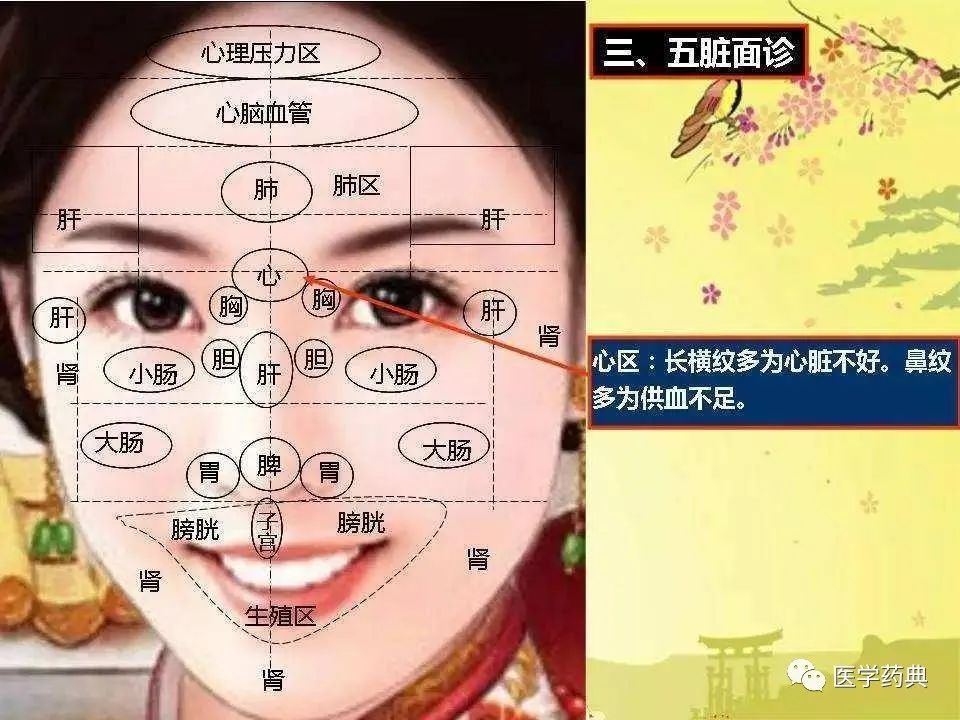
The Five Sense Organs and Disease
The five sense organs are important organs of the human body, closely related to the five internal organs. If the five sense organs feel uncomfortable,
the five internal organs are gradually weakening, leading to disease.
1. If the eyes suddenly become blurry, the corners are dry, and vision is unclear, this is a precursor to liver dysfunction. Pressing around the liver will feel swollen. In addition to seeking timely medical attention, one should also pay attention to eye hygiene and avoid excessive eye strain, as improper use of the eyes can also affect the liver.
2. If the ears constantly buzz and sounds are unclear, this is a signal of gradual kidney dysfunction, sometimes accompanied by symptoms such as foot pain, back pain, and frequent urination. Those who work excessively should especially pay attention to balancing work and rest, avoiding overexertion, and reducing alcohol and spicy food intake.
3. If the sense of smell is dull, frequent coughing occurs, and sometimes even breathing difficulties arise, this indicates gradual lung dysfunction. Patients should first pay attention to their diet, quit smoking or control their smoking amount, and avoid being around heavy smokers. Eating more fresh fruits and vegetables and strengthening physical exercise can prevent lung complications.
4. If the lips feel numb, appetite decreases, and the body gradually loses weight, this indicates gradual pancreatic dysfunction, mainly due to dietary imbalance and improper eating habits. When the pancreas is not functioning well, it also affects the stomach, leading to noticeably dry and cracked lips, numbness, and lack of taste. In addition to adjusting the diet, one should also avoid eating raw, cold, or greasy foods.
5. If the sense of taste is dull, unable to taste flavors, accompanied by palpitations, frequent dreams, and insomnia, this indicates damage to heart function. This is caused by excessive labor. When the mouth feels dry, the tongue coating is thick, and food flavors cannot be tasted, one should be especially vigilant to prevent heart disease.
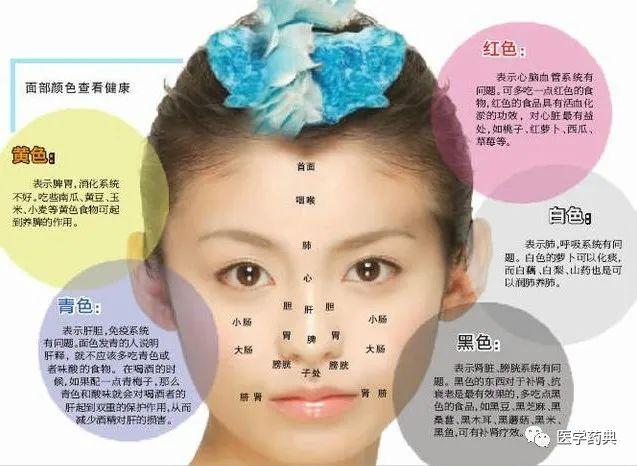
Comprehensive Explanation of TCM Facial Diagnosis
1. A slightly yellowish face with a rosy complexion, full of spirit, natural expression, and slight luster — indicates a normal person.
2. A flushed face, excitement, flaring nostrils, lip herpes, painful expression, rapid breathing and pulse — indicates acute illness, such as lobar pneumonia, dysentery, or acute purulent tonsillitis.
3. Facial swelling, pale eyelids, small eye fissures, and a noticeable indentation on the forehead, especially severe in the morning — indicates acute or chronic nephritis, kidney disease, etc.
4. A haggard face, gray complexion, dull eyes, and lack of spirit — indicates chronic wasting disease.
5. A pale face, swelling, wide and loose eyelids, dull and cold expression, white showing above the black of the eyes, and bulging eyeballs — indicates hyperthyroidism.
6. A pale face, swelling, lack of expression, thick tongue, hoarse voice, deafness, and rough skin — indicates hypothyroidism.
7. Facial swelling, dark red cheeks, and cyanotic lips — often indicates rheumatic heart disease or mitral stenosis.
8. Enlarged head, elongated face, protruding jaw, prominent cheekbones, and enlarged ears and nose — indicates acromegaly.
9. Dull response, apathetic expression, vacant gaze, and little speech — indicates typhoid fever.
10. A red, round, moon-like face, due to fat accumulation in the cheeks, may not show the ears from the front — often indicates long-term use of adrenal cortex hormones, Cushing’s syndrome.
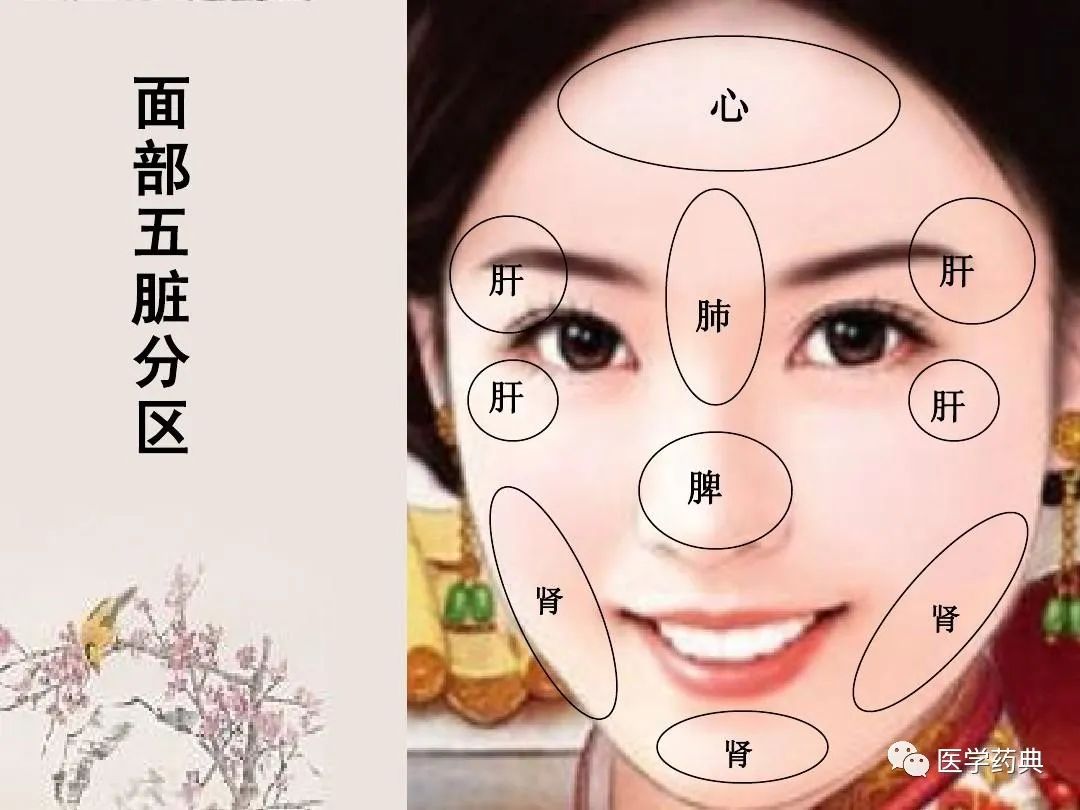
11. Facial muscle rigidity, expressionless during speech or movement, resembling a mask — indicates tremor paralysis and encephalitis.
12. A pale face with a lead-gray color, apathetic expression, sunken eyes, prominent cheekbones, and a sharp nose — often indicates severe hemorrhage, shock, acute peritonitis, etc.
13. Conjunctival congestion, redness of the face and eye socket, neck, and chest skin, fading upon pressure — often indicates epidemic hemorrhagic fever.
14. In the absence of jaundice, a dark brownish-black face with a grayish-blue tint — often indicates liver cirrhosis or late-stage liver cancer.
15. A crooked mouth towards the healthy side, inability to whistle or puff cheeks, enlarged eye fissures, inability to close eyelids, tearing, and disappearance of forehead wrinkles — often indicates facial nerve paralysis.
16. Nodular hyperplasia and patches on the face, merging into large uneven nodules, partial or complete loss of eyebrows and eyelashes, resembling a lion’s face — often indicates lepromatous leprosy.
17. A thin and pale face, rosy cheeks, significantly accompanied by low fever in the afternoon — indicates active pulmonary tuberculosis.
18. A sallow face, flat nose, almond-shaped eyes, swollen eyelids, wrinkled forehead, thick lips, extended tongue, and fatigue — indicates congenital idiocy.
19. A haggard face due to diarrhea or vomiting, sunken eyes, a high and thin nose, and prominent cheekbones — indicates severe dehydration.
20. A face resembling a “black person,” with black-blue pigmentation on the gums and buccal mucosa — indicates chronic adrenal cortical insufficiency.
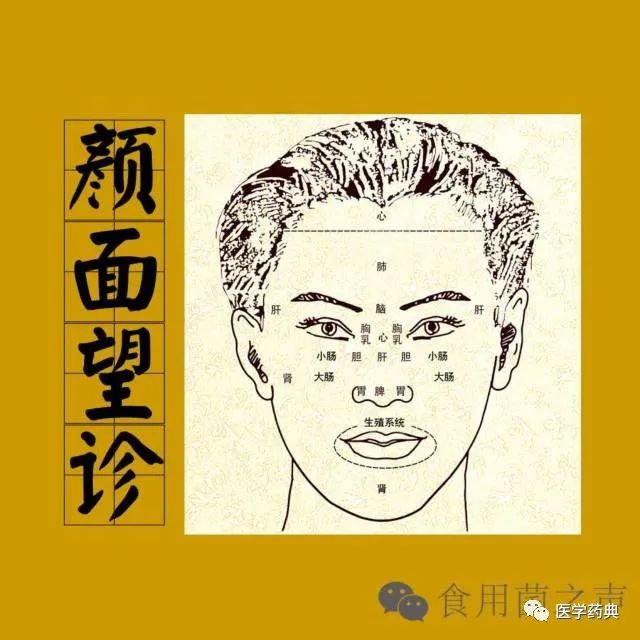
21. If a deep wound from trauma leads to difficulty opening the mouth days later, facial muscle spasms, and a peculiar smile resembling a bitter smile — often indicates tetanus.
22. Laughing foolishly, constantly looking in the mirror, making faces, childish emotional responses, and disordered behavior — often indicates juvenile-type schizophrenia.
23. Manic laughter — indicates mental illness, such as reactive psychosis, hysteria, arteriosclerotic psychosis, mania, etc.
24. Silly laughter — often seen in congenital idiocy due to chromosomal abnormalities, as well as in cases of maternal exposure to radiation or viral infections during pregnancy, and sequelae of difficult labor, encephalitis, or meningitis.
25. Forced laughter — often a sequela of multiple cerebrovascular accidents, also seen in multiple sclerosis, often accompanied by forced crying, speech, and swallowing difficulties.
26. Strange laughter, winking, pouting, tongue sticking out, frowning, and eye squinting — often seen in patients with chorea.
27. Dull laughter, often with an open mouth, drooling, and unconscious laughter — often seen in elderly diffuse cerebral arteriosclerosis.
28. Fake laughter, with enlarged eye fissures, flat nasolabial folds, drooping mouth corners, and facial asymmetry — indicates facial nerve paralysis.
29. A long-term abnormal face and lack of spirit — should seek hospital examination and treatment.
30. A sudden yellow face — may indicate jaundice hepatitis, cholecystitis, or hookworm disease.
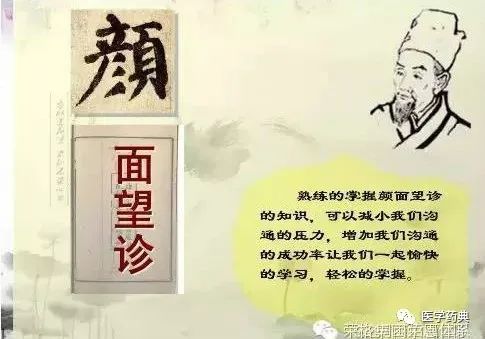
31. A blue face — often indicates respiratory diseases, such as tuberculosis, emphysema, pneumonia, chronic bronchitis, etc.
32. A gradually darkening face — may indicate liver cirrhosis.
33. Swollen eyelids — indicate “water retention” in the body, insufficient sleep; if swollen eyelids are more severe in the morning — indicates heart or kidney issues.
34. White patches on the cheekbones or facial area — may indicate vitiligo or cancer.
35. Yellow skin, dull hair, and easily tangled hair — indicate thyroid secretion disorders.
36. Excessively pale skin — may indicate anemia.
37. Red skin — indicates high red blood cell content or issues with the heart, liver, and intestines.
38. Half-moon milky white patches on the eyelids — may indicate high cholesterol levels in the blood.
39. Changes in moles on the face, such as color darkening, enlargement, or irregular edges — may indicate skin cancer.

Facial Features
The face of an infant is clean, and only after weaning and starting solid food does it show the capabilities of the heart, liver, spleen, stomach, and kidneys; as age increases, the conditions displayed on the face become more numerous. This includes acne, moles, spots, scars, and wrinkles; generally, adolescents show acne, middle-aged individuals show wrinkles, and the elderly show spots.
Specific features:
1. The cardiovascular pressure area mostly has acne, spots, and wrinkles.
2. Liver area: fish tail wrinkles and spots.
3. Gallbladder area: appears blue.
4. Lung area: appears dark, indicating poor lung function.
5. Brain area: vertical lines (the inner side of the eyebrows has a川字 pattern, or three lines, or two lines) indicate poor cardiovascular health; a red glabella indicates thick blood lipids, often indicating hypertension.
6. Heart area: horizontal lines (one, two, or several lines) often indicate heart issues. Nose lines often indicate insufficient blood supply.
7. Spleen and stomach area: abnormal color (or red nose) often indicates disharmony of the spleen and stomach.
8. Reproductive area: abnormal color appears blue, often indicates endocrine disorders.
9. Kidney area: appears dark, indicating kidney deficiency. Red bumps indicate back pain and general soreness, and a sunken area on the side of the cheek indicates kidney deficiency; small ears indicate kidney deficiency.
10. Large intestine and small intestine area: spots and “dark colors” indicate poor liver function.
11. Chest and breast area: dark color corresponds to one side.
12. Bladder area: dark and black, with acne; indicates bladder issues.
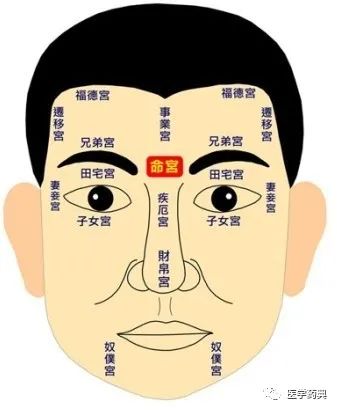
Comprehensive Body Supplementation:
1. General Overview
1. Moles and spots on the face indicate congenital organ dysfunction in that area.
2. Spots on the face indicate chronic diseases formed by long-term chronic consumption (formed over 3-5 years).
3. Acne on the face indicates inflammation in the organs in that area (formed in a short time).
4. Full-face acne and spots indicate endocrine disorders or decreased liver immune function.
2. Specific Discussions
1. Psychological stress:
The reflective area is on the forehead, from 1/3 to the hairline (the hairline circle). If acne (bumps) appears here, or if the forehead color differs, it indicates that the person is under significant psychological stress. If spots appear, it indicates heart disease (such as myocardial weakness); moles indicate congenital heart function deficiency.

2. Heart:
The reflective area is on the bridge of the nose between the corners of the eyes. If horizontal lines appear here or are prominent, it indicates arrhythmia or poor heart condition; if deep horizontal lines appear and there are also deep vertical lines on the tongue (grooves), it may indicate serious heart disease. Heart disease generally indicates poor small intestine function; it can also lead to diseases of the blood vessels, brain, thyroid, and parathyroid. Wrinkles on the lower lip indicate coronary heart disease, and purple lips indicate heart disease.
3. Brain:
The reflective area is between the eyebrows. If vertical lines appear here, and if this area is red, it indicates insufficient blood supply to the heart and brain, headaches, neurasthenia, frequent dreams, poor sleep, palpitations, and irritability.
4. Lungs:
(Respiratory system, throat, trachea, tonsils, etc.): The reflective area is between the eyebrows and 1/2 between the eyebrows; the area below 1/3 of the forehead. If the middle of the forehead is relatively sunken, and the color is dark, or bluish, or has spots, it indicates lung disease and difficulty breathing; if there are acne, it indicates that the person has recently had a cold or sore throat. If there are moles, spots, or whiteness in the eyebrow area, it indicates pharyngitis, tonsillitis, or chest tightness and shortness of breath, or lung disease. A bulge in the upper eyebrow area also indicates lung disease. People with poor lung function generally have poor large intestine excretion function.
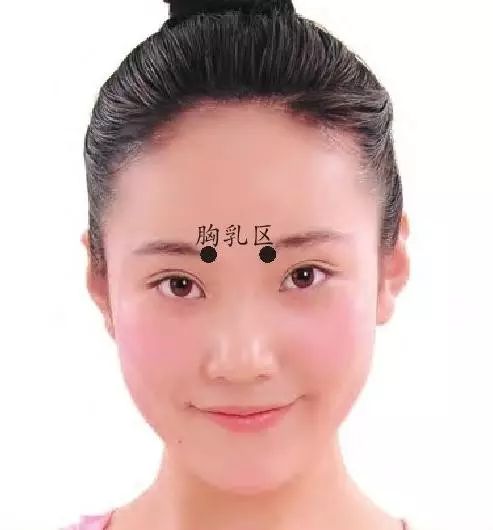
5. Chest (Breast):
The reflective area is between the corners of the eyes and the bridge of the nose. If a male has a dark or bluish area here, it indicates chest tightness and shortness of breath. If a female has a dark or bluish area here, it indicates breast swelling and pain during menstruation. If there are moles or acne in the inner upper eyelid area, it indicates lobular hyperplasia in females, and pleurisy in males. If there are small bumps in the corner of the female’s eyes, it indicates breast hyperplasia or breast tumors.
6. Liver:
The reflective area is at the outer part of the bridge of the nose, from 1/2 of the eyebrows to above the temples, and below 1/3 of the forehead, and the middle section of the bridge of the nose (the highest point of the bridge). If these two areas are dark or have spots, and the person is relatively young or a wealthy boss or high official, it may indicate fatty liver. If these two areas or one of them has acne (bumps), it indicates excess liver fire. If there are spots at the temples, it indicates weakened liver function. If there are spots at the highest point of the bridge of the nose, it may indicate excessive liver fire, emotional instability, or menopause. If both areas have obvious spots, and the face appears dark and dull, looking unattractive and thin, it indicates liver disease (hepatitis or cirrhosis). A mole in the center of the eyebrows, yellow sclera, and a very yellow face indicate hepatitis B. A blue line from the bridge of the nose to the tip may indicate cancer or tumors!
7. Gallbladder:
The reflective area is at the outer part of the highest point of the bridge of the nose. If there are red blood vessels, acne, or if the mouth is bitter upon waking, it indicates mild inflammation of the gallbladder; if there are spots, it may indicate cholecystitis. If there are vertical lines or vertical lines when smiling, it indicates gallbladder issues. If there are moles, it indicates congenital gallbladder dysfunction. If the right hand is placed under the right rib (the gallbladder is in this area), and the left hand punches the back of the right hand, if it hurts, it indicates cholecystitis; if it hurts severely, it may indicate gallstones. People with gallbladder issues may be overweight. A pair of obvious spots or moles under the eyes indicates gallstones. Dark eye bags also indicate gallbladder issues.
8. Kidneys:
The reflective area is where a vertical line from the outer corner of the eye intersects with a vertical line from the middle of the ear down to the chin. If there are red blood vessels, acne, or spots in this area, it indicates kidney deficiency, generally accompanied by fatigue, back pain, and leg soreness. If there are deep and large spots in this area, it may indicate kidney stones. If there are diseases or moles in this area, it indicates congenital kidney dysfunction, which can also lead to bladder, reproductive system, and gonadal diseases. Deep crow’s feet at the corners of the eyes, and vertical lines near the ears also indicate kidney deficiency. If there are diseases or moles in the kidney area and deep vertical lines in the brain area, it indicates hypertension or a future risk of cerebral thrombosis.
9. Bladder:
The reflective area is at the sides of the nose below the philtrum. If this area is red, with red blood vessels, acne, or sores, it indicates cystitis, which may cause red-yellow urine and slight urgency; cystitis can also cause lower back pain. In females, cystitis may sometimes indicate gynecological issues. If the root of the nose is red, but there is no urgency or frequency, and the entire bridge of the nose is red, it indicates rhinitis.
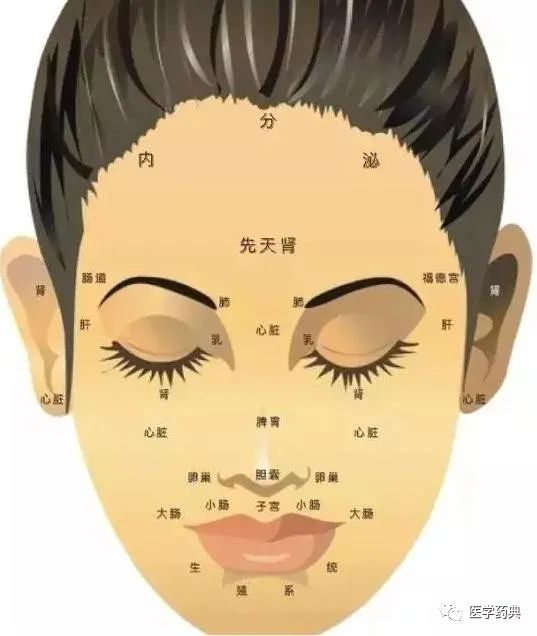
10. Spleen:
The reflective area is at the tip of the nose. If the tip of the nose is red or has rosacea or is swollen, it indicates spleen heat or spleen enlargement, generally accompanied by a heavy head, cheek pain, and irritability. If the tip of the nose is yellow or white, it indicates spleen deficiency, which may cause excessive sweating, aversion to wind, lethargy, and lack of appetite.
11. Stomach:
The reflective area is at the wings of the nose. If the wings of the nose are red, it indicates stomach fire, leading to hunger and bad breath. If there are red blood vessels and it is severe, it generally indicates gastritis. If there is stomach pain before meals, it generally indicates gastritis. If there is abdominal pain one to two hours after meals, it indicates a gastric ulcer, with the pain point in the middle of the abdomen or slightly to the left; if there is abdominal pain two to four hours after meals, it indicates a duodenal ulcer, with the pain point between the ribs near the heart, similar to a needle prick, and in severe cases, it may radiate to the back, with the pain point in the abdomen slightly to the right. If the wings of the nose are grayish-blue, it indicates stomach cold, and when shaking hands, one can feel that the person’s fingertips are cold, indicating that the person has stomach pain due to wind-cold, diarrhea, etc. If the wings of the nose are sunken, it generally indicates a history of stomach pain, which can lead to atrophic gastritis, and atrophic gastritis has a high possibility of leading to stomach cancer. If the wings of the nose are thin and have deep grooves, it indicates atrophic gastritis.
12. Small Intestine:
The reflective area is below the cheekbones, towards the inner side. If there are red blood vessels, acne, spots, moles, or freckles in this area, it indicates poor absorption function of the small intestine, and the person generally appears thin.
13. Large Intestine:
The reflective area is below the cheekbones, towards the outer side. If there are red blood vessels, acne, spots, moles, or freckles in this area, it indicates poor excretion function of the large intestine, and the person generally experiences dry stools, constipation, or diarrhea; if there are crescent-shaped spots in this area, it indicates constipation or hemorrhoids. The intersection of the lower line of the nose and the outer corner of the eyes is the rectal reflex area; if there are spots here, it indicates hemorrhoids; if this area is red or has white spots, there is a possibility of rectal cancer.
14. Reproductive System:
The reflective area is around the philtrum and lips. If a female has moles or spots below her lips, and the kidney reflective area is relatively clean, it indicates a retroverted uterus and back pain. If a female has moles or spots around her lips, and the kidney reflective area is also poor, or if the area around her lips is blue, black, or white, and the kidney reflective area is also poor, these two situations generally indicate sexual coldness. If a female has a mole in the philtrum, it generally indicates uterine disease. If a male has moles or spots around his lips, and the kidney reflective area is also poor, it indicates reproductive system issues. If a male over 40 has a thicker upper lip, it may indicate prostate enlargement; if the upper lip has acne that recurs, it may indicate prostatitis. If a male’s upper lip is uneven with grooves, it indicates male sexual dysfunction; if both sides of the upper lip are red, it also indicates prostatitis.
Appendix:
(1) If there are moles on the upper eyelid, it indicates dizziness.
(2) Any area with moles or spots indicates that ancestors suffered from diseases in that area.
(3) Diabetes: A pitted tip of the nose with red blood vessels in the kidney area and red wings of the nose. Puffy eyelids and cracked lips with a red line in the middle of the tongue may indicate diabetes. (4) Dark areas around the eyes indicate insufficient blood supply to the brain, easily leading to trigeminal neuralgia and poor sleep.
(5) If there are two blue veins in the throat, it indicates rheumatic arthritis.
(6) Spots on the entire face indicate thrombocytopenia.
The area of the forehead close to the hairline, if symptomatic, indicates poor cardiovascular function or significant mental stress. If there are moles, it indicates congenital cardiovascular dysfunction. If there are bumps or redness, blueness, purpleness, blackness, or darkness, it indicates current or long-term poor cardiovascular function or significant mental stress. If there are spots or pigmentation, it indicates long-term poor cardiovascular function or long-term mental stress.
The area between the eyebrows and the inner half of the eyebrows represents the respiratory system, lungs, throat.
The outer half of the eyebrows includes the temples, representing the liver.
Below the eyes, above the cheekbones represents the gallbladder.
The bridge of the nose between the eyes represents the cardiovascular system.
Between the eyes and the sides of the bridge of the nose, males represent the thorax, females represent the mammary glands, both are viewed crosswise.
Another position of the liver is at the midpoint of the bridge of the nose, and the gallbladder is on both sides of the midpoint of the bridge of the nose, hence the saying that the liver and gallbladder are interconnected.
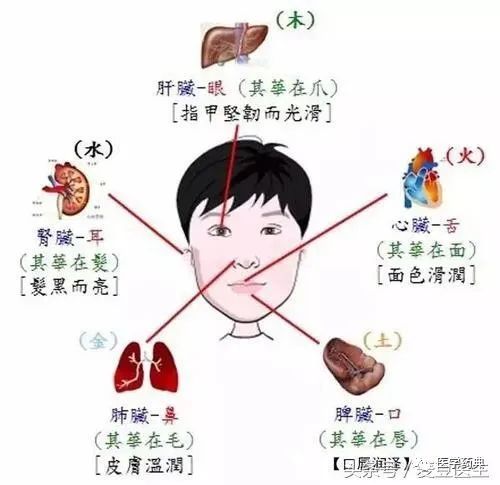
The tip of the nose represents the spleen, and the wings of the nose represent the stomach.
From the lower part of the cheekbones to the lower end of the tip of the nose, the outer side represents the large intestine. The inner side represents the small intestine.
The area between the cheekbones and the ears, including the ears and cheeks, represents kidney function.
The philtrum represents the bladder. The area around the mouth represents the reproductive system.
The chin represents the kidneys or indicates soreness; full-face acne indicates significant mental stress.
Extremely difficult to treat or untreatable facial features
Any of the following “death” features should be approached with caution:
1: Blackness on the glabella, tip of the nose, and both corners indicates difficulty for three days.
2: Dry, upright hair indicates difficulty for 15 days.
3: Blue energy from the hairline down to the glabella, regardless of the severity of the illness, indicates death in 60 days; if it reaches the bridge of the nose, death in one month; if it reaches the philtrum, difficulty for seven days.
4: A white line from the glabella to the ear or nose also indicates death.
5: A withered black, gray, or deep blue face indicates certain death. (Note: complexion is the first intuitive impression, do not scrutinize too closely)
6: A black forehead, heavy head, stiff neck, and downward gaze also indicate untreatable individuals.
7: Long-term severe illness with fixed dilated pupils indicates impending death.
8: A completely dry and black nose also indicates untreatable conditions.
9: A white horizontal line or purple-black color connecting the life gate (in front of the ear) to the middle of the nose indicates death.
10: Black energy entering the philtrum also indicates death.
11: Dry, white-yellow corners of the mouth indicate difficulty for seven days.
12: Blue lips and a black tongue like pig liver indicate a 90% chance of death.
(Note: complexion is the first intuitive impression, do not scrutinize too closely; rely on intuition for diagnosis, and be confident.)
The article is compiled from online sources, copyright belongs to the original author. If there is any infringement, please contact us for deletion.If you find our content good, please take a moment to:1. Set the “Gansu Province Famous TCM Inheritance Research Association” public account as a star⭐2. After reading each article, remember to click “Looking” at the bottom right.

